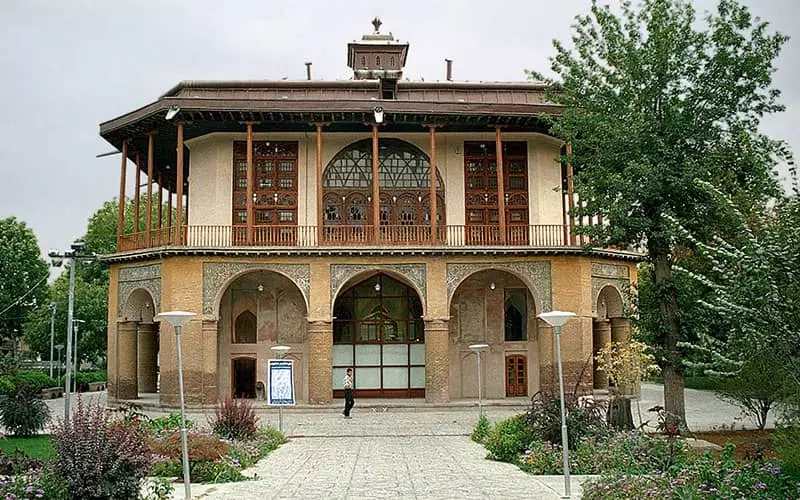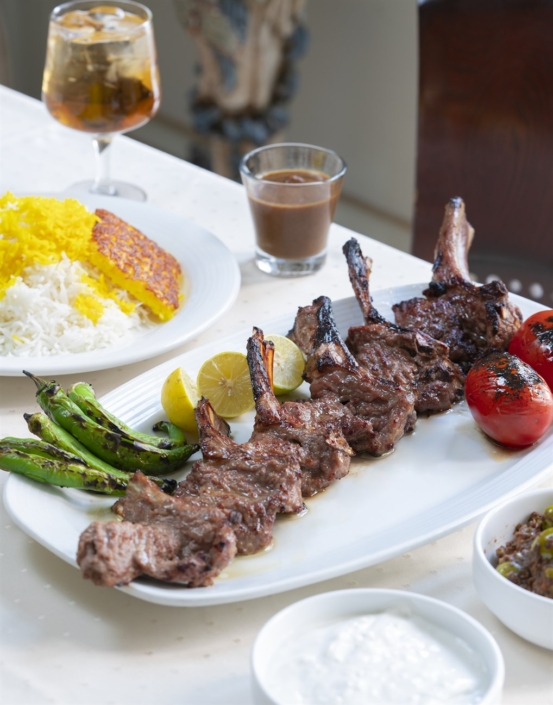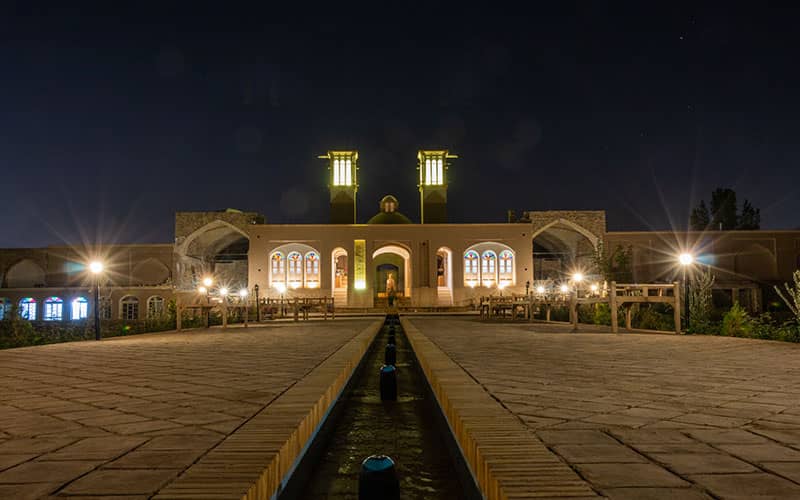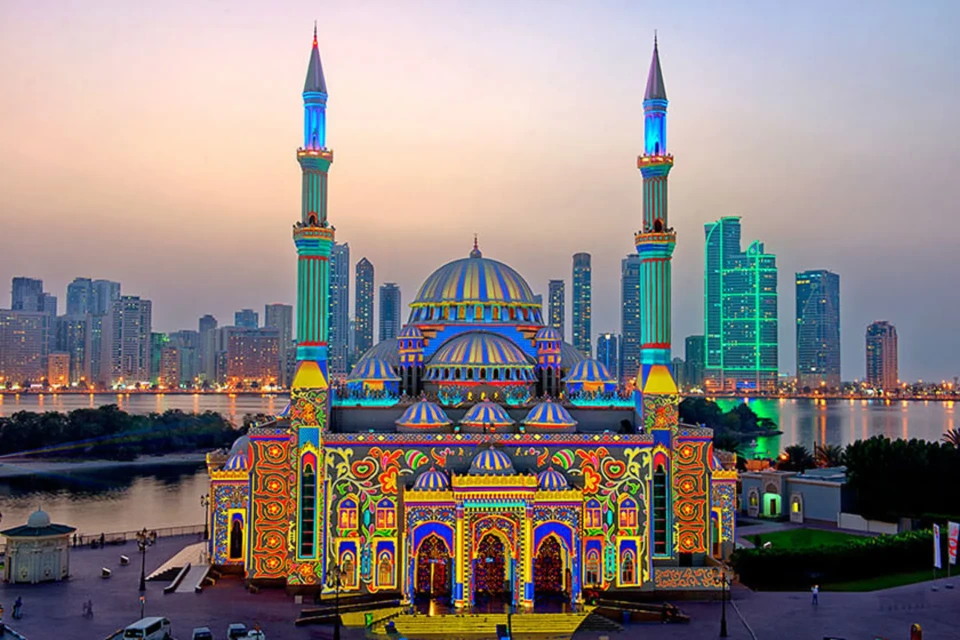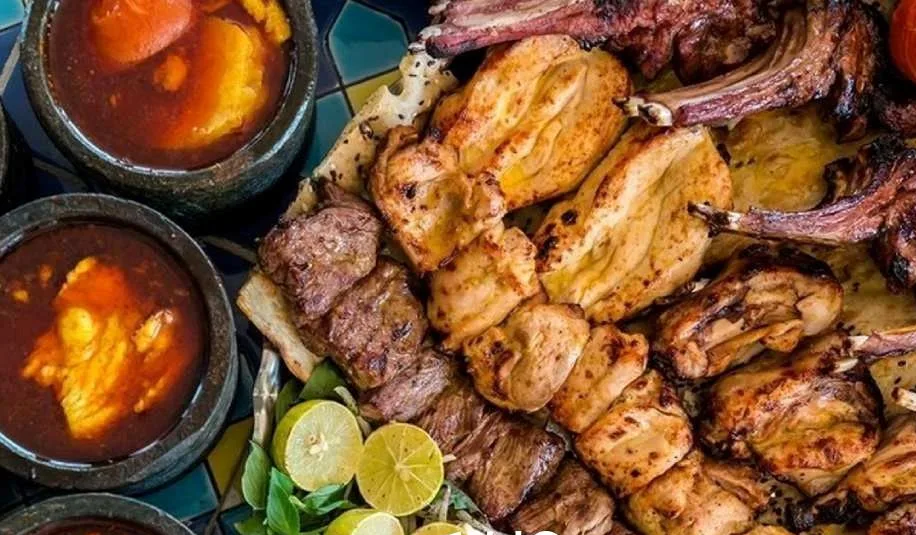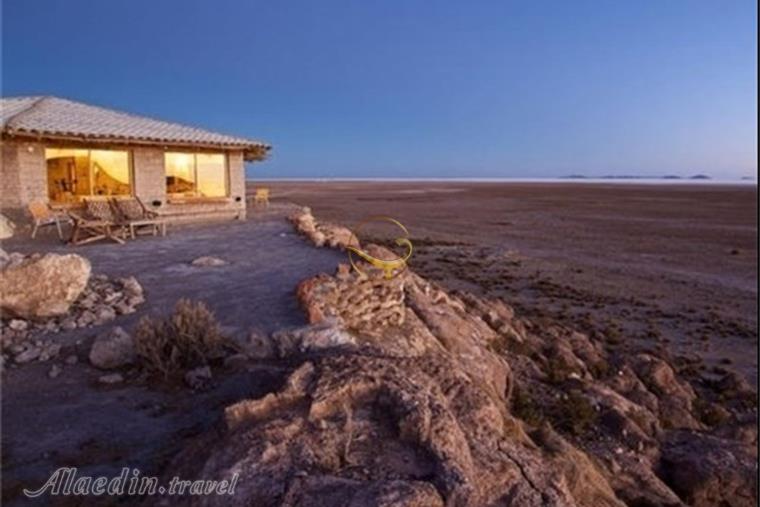Travel Guide to Qazvin | Qazvin iran
A Guide to Traveling Qazvin, Iran
Qazvin is a historic city in Iran that is located 160 kilometers northwest of Tehran. It was once the capital of Persia from 1555 to 1598 and is known for its rich history and culture. Qazvin is a popular tourist destination, and for good reason. The city is home to many beautiful historical sites, including palaces, mosques, and gardens. It is also a great place to experience Iranian culture, as the city is home to a variety of traditional bazaars, restaurants, and museums.
Qazvin is considered one of Iran’s developed and historical cities, which once served as the capital of Iran and has witnessed many ups and downs throughout its history. Alongside its cultural and historical attractions, its beautiful and pristine nature has further made it a preferred destination for a wide range of tourists.
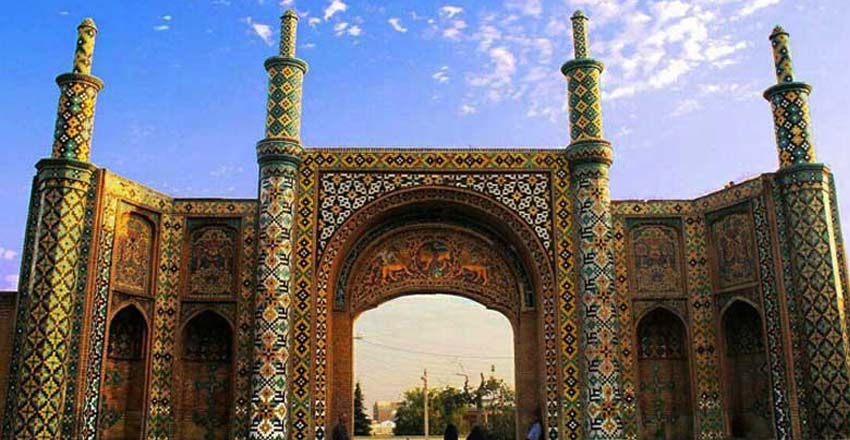
Here are some of the top things to see and do in Qazvin:
Visit the Sa’dabad Palace Complex:This grand palace complex was once the summer residence of the Qajar shahs. It is now a museum that is home to a collection of Persian art and artifacts.
Explore the Sheikh Lotfollah Mosque:This beautiful mosque is one of the finest examples of Persian tile work. The interior of the mosque is decorated with intricate mosaics that depict Qur’anic verses and floral patterns.
Wander through the Taleghani Bazaar:This traditional bazaar is a great place to find souvenirs, spices, and other goods. Be sure to haggle for the best price!
Relax in the Golestan Garden:This serene garden is a great place to escape the hustle and bustle of the city. The garden is home to a variety of flowers, trees, and fountains.
Visit the Jameh Mosque of Qazvin:This historic mosque is one of the oldest in Qazvin. The mosque is a UNESCO World Heritage Site and is known for its unique architecture.
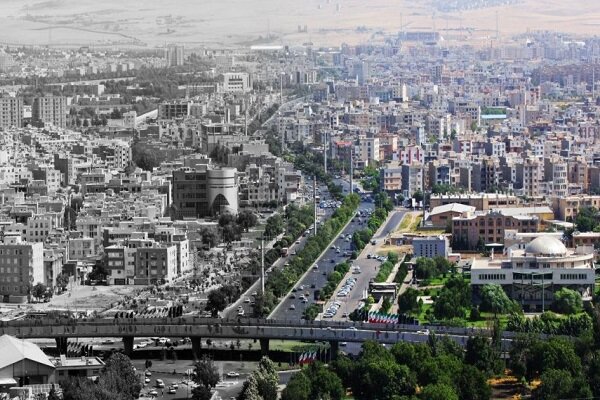
Here are some tips for planning your trip to Qazvin:
- The best time to visit Qazvin is in the spring or fall, when the weather is mild.
- Qazvin is a relatively affordable city to visit.
- The official language of Iran is Persian, but English is also spoken in some tourist areas.
- The Iranian currency is the rial. You can exchange money at banks and currency exchange offices.
- Tipping is not expected in Iran, but it is appreciated.
Climate of Qazvin:
Qazvin enjoys a moderate climate, with hot summers and cold winters. Spring and autumn are pleasant seasons to visit the city, with mild temperatures and occasional rainfall.
Attractions in Qazvin:
Qazvin boasts numerous cultural and historical sites, including ancient mosques, caravanserais, and historical houses. Notable attractions include the Jameh Mosque, Chehel Sotoun Palace, and Alamut Castle.
Shopping Centers in Qazvin:
There are several shopping centers in Qazvin, offering a variety of goods ranging from traditional handicrafts to modern commodities. Some popular shopping destinations include Moallem Mall and Saraye Vaziri Bazaar.
Souvenirs of Qazvin:
Visitors to Qazvin can purchase various souvenirs such as handwoven carpets, traditional ceramics, and local sweets like “Sohan” and “Gaz.”
Local Cuisine of Qazvin:
Qazvin is renowned for its delicious local cuisine, which includes dishes like “Abgoosht-e Qazvini” (Qazvin-style lamb stew) and “Mirza Ghasemi” (a dish made with roasted eggplant, tomato, and garlic).
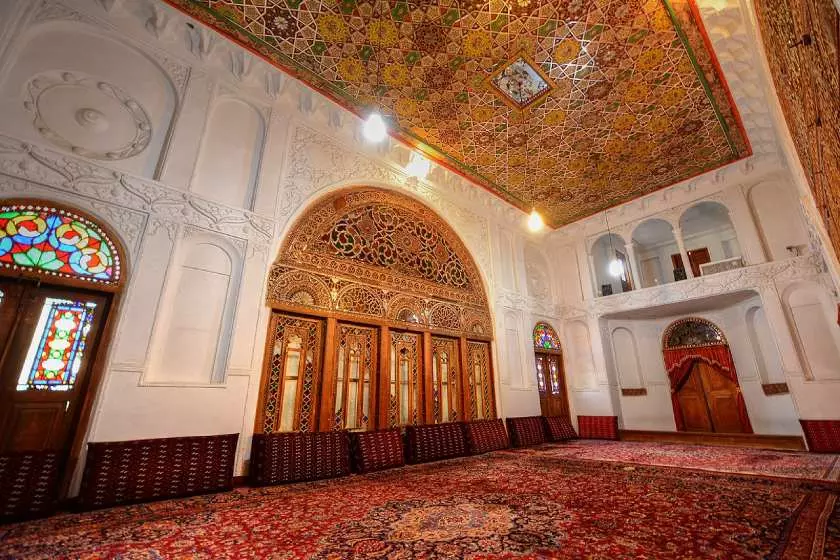
Accommodation in Qazvin:
Qazvin offers a range of accommodation options, including hotels, guesthouses, and traditional boutique hotels, catering to different budgets and preferences.
Restaurants in Qazvin:
The city hosts numerous restaurants serving a variety of cuisines, from traditional Persian dishes to international fare. Some popular restaurants include Khayyam Restaurant and Alborz Restaurant.
Customs and Traditions of Qazvin’s People:
The people of Qazvin are known for their hospitality and warmth. Visitors are advised to respect local customs and traditions, such as dressing modestly in religious sites and greeting locals with courtesy.
Public Transportation in Qazvin:
Qazvin has a well-developed public transportation system, including buses and taxis, making it easy for visitors to navigate the city.
Travel Guide to Qazvin:
For travelers planning a trip to Qazvin, it’s recommended to check the weather forecast in advance, pack appropriate clothing, and carry necessary documents and medications. Additionally, familiarizing oneself with local customs and language basics can enhance the travel experience.
Qazvin city is the capital of Qazvin Province, with a population of over 402,748 according to the 1395 census. Qazvin Province is situated in the southern foothills of the Alborz mountain range, bordered by Gilan Province to the north, Alborz Province to the east, Zanjan and Hamadan Provinces to the west, and Markazi Province to the south.
Archaeological findings in the Qazvin plain date back to 9,000 years ago, although the city’s history and establishment trace back to the Sassanian era. Its location on the Silk Road facilitated trade and contributed to the city’s prosperity in ancient times. During the Safavid era, Qazvin served as Iran’s capital for over half a century, and its numerous historical and cultural monuments testify to this fact. Qazvin has 12 sister cities, including Denizli (Turkey), Haikou (China), Osan (South Korea), Parma (Italy), and Yerevan (Armenia).
Qazvin city used to have eight gates named Roshan Gate, Darb-e Koushk Gate, Tabriz Gate, Bagh Shah Gate, Sheikh Abad Gate, Old Tehran Gate, Khandaqbar Gate, and Imamzadeh Hossein Gate, of which only Darb-e Koushk and Tehran Gates remain.

In ancient texts, various names have been mentioned for Qazvin, including Rajia, Arsas, Ardpa, Kashwin, Qaswin (a city with steadfast people), and others. Some historians also consider Qazvin to be the Arabicized form of “Caspian” and believe that the Caspian people were the founders of Qazvin. Even in old Ottoman and Arabic texts, the Caspian Sea was referred to as “Bahr al-Qazwin.”
Interestingly, Qazvin was selected as Iran’s Clean City in 1392 due to its 2,500 hectares of orchards on the city’s outskirts and the Barajin Forest Park. Furthermore, the presence of renowned calligraphers such as Mir Emad Qazvini has earned Qazvin the title of Iran’s calligraphy capital. The city also excels in miniature painting, with the Qazvin school of miniature painting distinguished by features such as depicting the delicate bodies of young people and farmers and the three-faced figures.
Many prominent figures in various fields, including scientific, political, and artistic, hail from this region. Some of the most famous ones include Hamdollah Mostowfi, Obaid Zakani, Seyyed Ashraf al-Din Hosseini (Nasim-e Shomal), Mohammad Ali Rajai, and martyr Abbas Babaie.
Area code: 028
Qazvin Weather:
Qazvin’s location in central Iran results in a semi-arid and cold climate, with the hottest months being Tir and Mordad, and the coldest months being Dey and Bahman. Therefore, the best time to travel to Qazvin is spring, especially during the months of Ordibehesht and Khordad.
Qazvin Attractions:
Given the ancient history of Qazvin, numerous historical and cultural artifacts can be found in this region, which visiting them can acquaint you with the rich heritage of this borderland. Join us for a brief overview of some of Qazvin’s attractions.
Historical and Cultural Attractions of Qazvin:
The number of historical sites in Qazvin is so abundant that it ranks among the first in Iran and third in the world in this regard. Perhaps the most famous attraction in Qazvin is Al-Mout Castle, which is built at an elevation of 2,163 meters above sea level and was once the central base of operations for Hassan Sabbah. The castle is surrounded by cliffs on all four sides, with entrance possible only from the northeast side. The historical significance and value of this castle led to its registration as a national monument of Iran in 2002.
Aminiha Hosseiniyeh is an excellent example of Qazvin’s architectural masterpiece, originally built by a Qazvini merchant as a residential house and dedicated for holding mourning ceremonies in 1924. Beautiful stained glass windows, ceilings adorned with mirrorwork, paintings, plasterwork, and more characterize this historic and beautiful house among Qazvin’s attractions.
After visiting Aminiha Hosseiniyeh, take a stroll through Qazvin Bazaar located nearby. This national monument, dating back to the Safavid era, includes various sections such as the Mosque of the Prophet (Shah Mosque), Vazir Caravanserai, open and covered Timchehs, Saad al-Sultan Caravanserai, and Haj Reza’s Caravanserai. Interestingly, Saad al-Sultan Caravanserai is the largest urban caravanserai in Iran, built during the reign of Naser al-Din Shah. In addition to admiring the fascinating and ancient architecture of Qazvin Bazaar, you can interact closely with the locals and make some good purchases.
Another of Iran’s national treasures that should be included in your travel itinerary is Qajar Bath (Shahi Bath). Dating back to the Safavid era, this structure now operates as an ethnographic museum where you can explore sections dedicated to tribes, customs, traditions, and occupations.
Qazvin Grand Mosque (Jameh Mosque-e Qazvin) is important as it is considered one of the largest and oldest mosques in Iran. This national monument encompasses architecture from several historical periods, including Islamic, Safavid, and Qajar. The brickwork decorations, tilework, and beautiful inscriptions in various scripts make it appealing to any viewer.
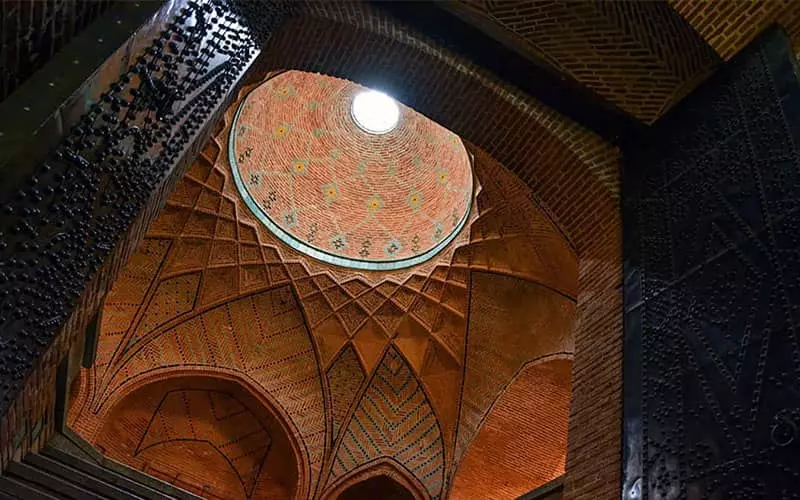
We cannot talk about Qazvin’s historical attractions without mentioning the Forty Column Palace (Kolah Farangi Mansion), which is the only surviving remnant of the royal palaces of the Safavid era and is registered as a historical monument of Iran. This two-story octagonal building with alcoves, plasterworks, and beautiful wall paintings has now been transformed into the Qazvin Calligraphy Museum. Qazvin’s palaces are not limited to this, and due to the city’s capital status during the Safavid era and the presence of princes and rulers in various periods, numerous palaces such as Bagh Sepahdari Mansion, Sardar Mofakham Mansion, Municipal Mansion, etc., exist in Qazvin, each of which is admirable and impressive.
If you want to see the first designed street in Iran, head to Sepah Street in Qazvin, which was constructed as a direct route during the reign of Shah Tahmasb Safavid. It was registered as Iran’s first street in the list of national monuments.
There are numerous water reservoirs in Qazvin, the most famous of which include Hakeem Water Reservoir, Women’s Bazaar Water Reservoir, Haj Kazem Water Reservoir, Sardar Koochak Water Reservoir, and others, some of which are among Iran’s national monuments.
Natural Attractions of Qazvin:
If you visit the Almout region, make sure to also visit Lake Avan, located near Almout Castle. This lake, registered as a natural heritage site of Iran, is nestled in a lush and mountainous area, attracting many tourists annually with its breathtaking and captivating scenery. Besides enjoying the picturesque views of the lake, you can also go boating and camping around the lake.
Varchar Waterfall, with its over 30-meter height, is attractive and fascinating in its own right, although access to it is not easy, and you’ll need to trek through rugged terrain. This waterfall is located 21 kilometers from Qazvin city and near the village of Razjerd.
Barajin Forest Park (Fadak Park) is one of Qazvin’s famous attractions, popular among both locals and tourists due to its recreational facilities and pleasant climate. In this forest park, you can visit the bird garden, pigeon house, and aquarium, and enjoy activities such as children’s workshops with animals, cycling trails, open-air cinemas, and amusement parks. Additionally, Iran’s first safari park is located here, allowing tourists to get acquainted with animals living freely in their habitat.
The first safari park in Iran is dedicated to Barajin Forest Park.
Near Barajin Forest Park lies Barajin Nature Village, which serves as a habitat for animals, especially native ones, and consists of various sections such as the bird garden, birds of prey, reptiles, carnivores, herbivores, aquarium, etc.
Many tourists during their trip to Qazvin also make use of Kharaqan Hot Spring, especially for its therapeutic properties, which are effective in improving neuralgia, sciatica, rheumatism, respiratory tract infections, etc. This spring is located 95 kilometers from Qazvin.
Shopping Centers in Qazvin:
Qazvin boasts several shopping centers such as Iranians, Aftab, Noor, and Ferdowsi. If you’re looking for souvenirs and unique handicrafts of this city, in addition to the old bazaar, be sure to visit Sa’d al-Saltaneh Caravanserai.
Qazvin Souvenirs:
A trip to Qazvin is incomplete without bringing back something from this city, especially with its diverse and delicious sweets, which are among the most famous souvenirs of Qazvin. The city has a long history in traditional sweets, and various occasions provide an opportunity for the skilled women of this land to showcase their pastry-making skills, from delicate Qazvini bread to Baghlava, Nane Berenji, Nan-e Charkhi, Padarazi, Badami sweets, Nan-e Chaayi, etc.
Another part of Qazvin’s edible souvenirs includes fruits such as pomegranates, Zoghal Akhteh, grapes, apples, apricots, as well as nuts (walnuts, almonds, pistachios, raisins), and pottery cheese.
If you’re looking for more enduring souvenirs, what could be better than carpets, rugs, and jajims, night tents, Sermeh-doozi, Navar-bafi, Golabatoon-doozi, Nam-Nam-doozi (a type of traditional embroidery), metal mesh, etc.? Qazvin handicrafts can be your memento from this trip.
Local Cuisine of Qazvin:
Undoubtedly, a significant part of any trip revolves around culinary exploration of traditional foods; Qazvin is no exception to this rule. Among the most famous local dishes of Qazvin is “Gheimeh Nesar,” with its unique color, gloss, and taste, enticing every traveler to try it. This dish is prepared using rice, lamb meat, orange peel, almond peel, pistachio peel, fried onion, saffron, barberry, etc., and is served at important gatherings, Nowruz celebrations, etc. Shirin Polo, Sweet Kuku, Qazvini Dimaj (snack), Ash-e Doogh, Ash-e Maash-e Piazoo, and other delicious dishes of Qazvin are must-tries during your trip to this region.
Accommodation in Qazvin:
For accommodation in Qazvin, you have numerous options ranging from four-star hotels to one-star hotels, guesthouses, eco-lodges, and more. Among the hotels in Qazvin, you can choose Iranian Hotel, Baghdad Hotel, MarMar Hotel, Alborz Hotel, Mir Emad Hotel, and Sina Apartment Hotel for a pleasant night stay. Eco-lodges such as Ela Amoot, Traditional House Khaneh Behroozi, Eco-lodge Qaleh Almuot, Eco-lodge Babajafar, etc., offer you a tranquil and serene rural life away from the hustle and bustle of the city for a few hours.
Restaurants in Qazvin:
Armani Restaurant is one of the famous restaurants in the city, offering a variety of fast food and international dishes alongside traditional cuisine, allowing you to satisfy your cravings. Other restaurants in Qazvin include Aghbali Restaurant, Namoneh Restaurant, Kermani Restaurant, Mediterranean Restaurant, and Sa’d al-Saltaneh Traditional Cafe-Restaurant.
If you’re into fast food, you can enjoy a tasty meal at Pizza Palace, Azhdar Zapata (central branch), Adish Fast Food, Pizza Tonight, etc.

Customs and Traditions of Qazvin:
One of the most famous customs of the people of Qazvin is known as “Panjah Bedar,” which bears a striking resemblance to the celebration of “Sizdah Bedar.” On this day, which coincides with the fiftieth day of the new year, people offer gratitude for the spring rains by reciting thanksgiving prayers. If there’s little rainfall, they pray for more rain from God. Following this, they seek refuge in nature and spend a memorable day outdoors by preparing traditional dishes such as Ash Reshteh, Dimaj, Ajil Meshkalgasha, and fruits. This traditional ritual was registered in the Intangible Cultural Heritage of Iran in 1389.
The Fandogh Festival is an interesting tradition in the Alamut region, which takes place annually with the beginning of the almond harvest in mid-August. Villagers gather in agricultural fields and, after spontaneously reciting some poems and singing together, engage in harvesting almonds. Subsequently, engaged girls make necklaces from almond kernels, called “Golovaneh,” for their future husbands and present them as gifts when winter arrives.
Samno cooking is one of the oldest traditions in Qazvin, which also has religious and superstitious aspects. Nowadays, it is often cooked before Nowruz in the old neighborhoods of the city. The cooking process of Samno is lengthy, so at the same time, a type of Ash (soup) is also prepared, and the participants are served. Reading the Ziaratnama of Hazrat Zahra (SA), reciting the Tawassul prayer, etc., are integral parts of this ceremony.
Public Transport in Qazvin:
Public transportation in Qazvin is relatively inexpensive. Taxis, buses, and even Snapp (ride-hailing service) in this area will take you to any part of the city at reasonable prices. Additionally, if you purchase the Qazvin Card for using the bus services, your transportation costs will be significantly reduced. Moreover, during the Nowruz holidays, the Qazvin Municipality operates special tourist buses, which will greatly enhance your sightseeing experience in the city.
Travel Guide to Qazvin:
If you’re planning a trip to Qazvin, you have various options for transportation depending on your budget and preferences. You can choose between train, bus, taxi, or private car. Since this city does not have an airport, air travel to Qazvin is not an option. Below, we’ll provide a brief explanation of the land travel options to Qazvin.
Land Travel to Qazvin:
Given that Qazvin has had a railway line since 1318, you can comfortably travel from your city to Qazvin by train. Traveling by train to Qazvin has its advantages, including cheaper travel costs and enjoying the scenic route.
The next option available is traveling by bus to Qazvin, which has its own fans. After arriving at the bus terminal, you can take a taxi to the city center or your accommodation.
Qazvin’s proximity to Tehran has led many residents of the capital to use their private cars for this journey. The distance from Tehran to Qazvin is 150 kilometers, and you’ll reach this beautiful city in about 2.5 hours of driving on the Tehran-Karaj-Qazvin freeway.
If you reside in the western part of the country, you can reach Qazvin via the Divandareh, Bijar, Qidar, Abhar, and Takestan route, covering a distance of 408 kilometers. Warm-hearted southerners can travel to Qazvin via the Sirjan-Bandar Abbas, Yazd, Kashan, and Qom route. This route, which is 1,380 kilometers long, takes about 15 hours but is certainly worth it.
For travelers from the eastern parts of Iran, such as the beautiful city of Birjand, you can take the 1,300-kilometer route via Ferdows, Bardaskan, Sabzevar, Shahrood, Damghan, Semnan, Tehran, and Karaj, which leads to Qazvin.

